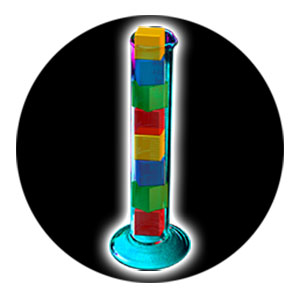
MENU

Building Blocks of Life
The way Stanley Miller’s 1953 experiment has been reported in biology textbooks, as well as the media, has led people to believe that life has been created in the laboratory by setting up conditions matching those which existed on the primeval earth. Miller designed a series of glass tubes and bottles in which he heated water and specific gases and sent electric sparks through them. It was reported that he had nearly created “life in a test tube” when actually he had managed to produce only some of the amino acids and simple compounds found in living things. Even so, Carl Sagan called it “the single most significant step in convincing many scientists that life is likely to be abundant in the cosmos.”1 In reality, Miller was nowhere near creating life. Lawrence Richards points out, “Miller’s experiment did make some of the amino acids found in living things. But this does not mean he showed how living things began. How do we know? First, all the right amino acids are found in dead bodies—but the bodies are still dead. Just having the right amino acids doesn’t make something alive.”2 Amino acids produced in Miller’s experiment compare to a cell the way three or four bricks compare to a fifty-story skyscraper! Richards also lists some of the difficulties which have convinced many scientists that the chance creation of life could never happen:
- The way some amino acids must be made in the test tube will destroy other amino acids.
- Without the protection of being in a living cell, amino acids would be destroyed as soon as they were created.
- Certain chemicals in a cell (porphyrins) can be made only if there is free oxygen in the atmosphere, but other chemicals (amino acids) can be made only if there is no free oxygen in the atmosphere.
- Many of the chemical compounds found in cells will automatically combine and destroy each other—anywhere except within a living cell.
- Even after thirty years of experiments, three key amino acids have not been made chemically even in experiments designed to produce them!3
Even Stanley Miller, over forty years after his famous experiment, had this to say in an interview for Scientific American: “The problem of the origin of life has turned out to be much more difficult than I, and most other people, envisioned.”4 “Much more difficult” is a grossly understated way of saying “impossible”! In 1984, Walter L. Bradley co-authored The Mystery of Life’s Origin, which caused a huge stir in scientific circles because it provided a “devastating analysis of theories about how living matter was created. Eyebrows were raised because its foreword was written by biologist Dean Kenyon of San Francisco State University, whose book Biological Predestination had previously argued that chemicals had an inherent ability to evolve into living cells under right conditions. Calling Bradley’s book ‘cogent, original, and compelling,’ Kenyon concluded: ‘The authors believe, and I now concur, that there is a fundamental flaw in all current theories of the chemical origins of life.’”5 Finally, in 1998 Klaus Dose, considered one of the foremost biochemists in the area of molecular evolution, published an article in Interdisciplinary Science Review in which he made the following statement:
More than thirty years of experimentation on the origin of life in the fields of chemical and molecular evolution have led to a better perception of the immensity of the problem of the origin of life on Earth rather than to its solution. At present all discussions on principle theories and experiments in the field either end in stalemate or in a confession of ignorance.6 (emphasis added)
- Robert Shapiro, Origins (New York: Summit Books, 1986), p. 99, as cited in Strobel, Lee. The Case for Faith. (Grand Rapids, MI: Zondervan Publishing House, 2000), p. 96.
- Richards, Lawrence. It Couldn’t Just Happen. (Fort Worth, TX: Sweet Publishing, 1987), p. 67.
- Ibid., pp. 67, 68.
- Stanley Miller as quoted in Strobel, pp. 107, 108.
- Charles B. Thaxton, Walter L. Bradley, and Roger L. Olsen, The Mystery of Life’s Origin (Dallas, TX: Lewis and Stanley, 1984), back cover, as quoted in Strobel, p. 93.
- Klaus Dose, “The Origin of Life: More Questions Than Answers,” Interdisciplinary Science Review 13 (1998), p. 348, as quoted in Strobel, p. 107.

“. . . There is a fundamental flaw in all current theories of the chemical origins of life.”
Evolutionary biologist
Dean Kenyon
Design, graphics and artwork copyright © 2016 Tim Beasley • All rights reserved.